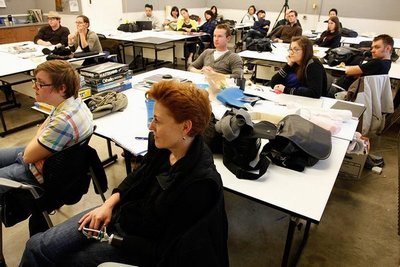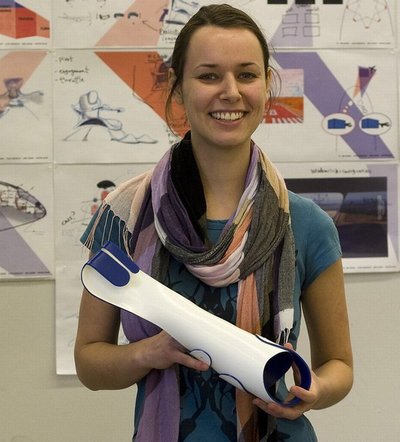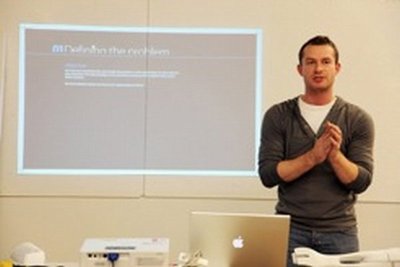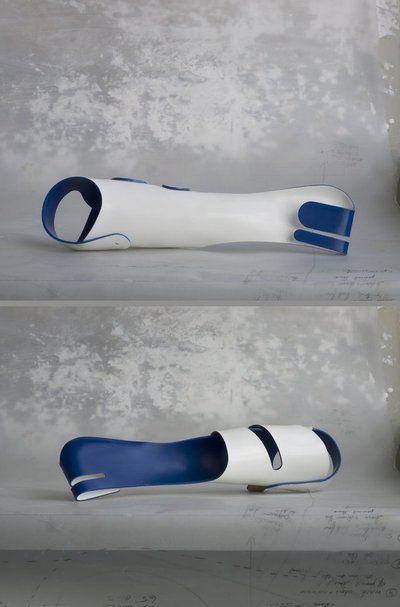February 11, 2010
Students face real-life design challenge: A simple, cheap and effective prosthetic arm
In fall quarter, 21 UW industrial design students received a challenge to “not do what’s always been done.” Their answers to that challenge will be on display in the Jacob Lawrence Gallery Friday and Saturday, Feb. 19 and 20.
The challenge came from Joanne Tilley, an artist whose arm was amputated below the elbow. Like most in her situation, Tilley uses a prosthesis — one that ends with a hook. But she believes that better designs are possible.
“It should be a marriage of function and design, like in architecture or even fashion,” she said. “What if Apple designed a prosthesis? What if I.M. Pei designed one? What would those look like?”
She went to Magnus Feil, an assistant professor of art, with a proposal: Teach a design studio focused on prosthetic arms. Feil decided his industrial design seniors were up to the challenge.
The class began with history. Prosthetic arms, Feil said, haven’t changed much in the last 100 years. “If you look at articles in magazines at the turn of the last century, they pretty much look like prosthetic devices today,” he said. “There’s a shaft and then a connective device and it’s mostly a hook. It’s not terribly functional. It just has a trapping function, and aesthetically it’s not pleasing.”
In recent years, of course, scientists have developed myoelectric arms that have sensors and motors to try to replace what’s missing. “It’s quite stunning what can be done,” Feil said, “but the drawback of those arms is that they’re very complicated and very expensive. They can easily cost $50,000 and more, so not everybody can afford one.”
His students’ charge was to develop prosthetic devices that would be simple and inexpensive to produce, aesthetically pleasing but also more functional than the typical hook found on standard devices. Tilley visited the class early in the quarter with her gym bag full of the devices she owns. Students were able to look at them and hear her explain how they worked. They also saw videos of how the devices are made and listened to presentations by some local experts.
Then each one began to explore ideas. In industrial design, Feil explained, the research phase is followed by what he calls ideation. The designer looks around for models — in some cases, animals with grasping abilities, or machines that execute similar functions — and tries to abstract useful concepts from them. In the class, the students also simulated having a prosthesis by taping up their fingers and trying to perform everyday functions such as tying their shoes.
The next step is to experiment with mock-ups, which are made out of a foam material similar to insulation foam. And then there are models. Through the process, Tilley visited the class on a regular basis and gave the students feedback.
The 21 models the students came up with will be on display in the exhibit, and they are a varied lot. One, for example, uses the kind of flexible nylon bands that are used to strap loads onto trucks. The bands are looped, so the user slides the strap over an object and uses the functioning hand to tighten it with a built-in ratchet device, giving a strong grip on the object. Another uses three flexible prongs that look a bit like flower petals and can be operated individually, so the person can hold a spherical object with all three prongs and a drinking glass with just two.
One of the students, Dana Badeen, said she was focusing on cost with her arm, because she had learned from Tilley that the hooked devices cost between $5,000 and $10,000 and need to be replaced every three to five years. She used a flat piece of plastic that can be molded around a plaster cast of a person’s arm. On one end the plastic is folded over, forming a softer looking hook with which to pick things up. The folded area also has a slot in the middle, so an item such as a pencil can be held. She said the whole thing can be made for $25.
“I learned in this project that you can’t do everything with one design solution,” Badeen said. “I decided to push myself to prioritize and make something that would do the things most important to the user.”
Stephen Stum also narrowed down the things his arm could do to grabbing, pinching and lifting. His design is slimmer than an arm and has a piece that protrudes out from it. The piece opens and contracts using a slider function. He also addressed the problem of lifting heavy objects, which can be difficult for amputees because it puts too much pressure on the remaining stump. Stum designed a neoprene brace that helps support extra weight.
Both Badeen and Stum said they were conscious of how their designs looked as well as how they functioned. Badeen likened it to someone who chooses stylish glasses to overcome nearsightedness. “They want something fashionable that they can customize with patterns and colors,” she said. “I don’t know why a prosthesis can’t be the same way.”
“We’ve been told before that people have emotional connections to objects, but it just never sunk in for me until this project,” Stum said. “Seeing Joanne and knowing that someone was going to be wearing this device, it made me want to give it a cool factor — something people would want to look at instead of wanting to look away.”
Tilley was pleased with how the studio turned out. “The students took the project seriously,” she said. “I was impressed by their desire to dig in and get perspective on something they didn’t have any connection to. I found them smart, ingenious and caring.”
Are any of the student-designed prostheses headed for production? Maybe someday, but more work would be required. Feil explained that given the short time period of an academic quarter, the students couldn’t make truly functional prototypes. But some special guests have been invited to the exhibit’s opening — people who are involved with prosthetic devices in one way or another — so a dialogue could get started. And Tilley, who sometimes builds her own devices, says she is interested in some of the designs.
“I hope there will be more exchange of ideas with our guests,” Feil said. “I don’t see this project as being finished. I see it as a start.”
In addition to the students’ models, the exhibit will include photos of the models taken by Ellen Garvens, an associate professor of art who teaches photography. It happens that prosthetic devices are an ongoing theme in her work, so the collaboration was natural.
The exhibit will run from noon to 6 p.m. on Friday, Feb. 19, and from 10 a.m. to 4 p.m. on Saturday, Feb. 20, in the Jacob Lawrence Gallery, 132 Art. There will be an opening reception at 6 p.m. Friday. The exhibit is free and open to the public.




